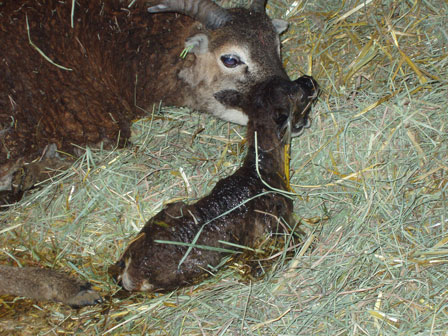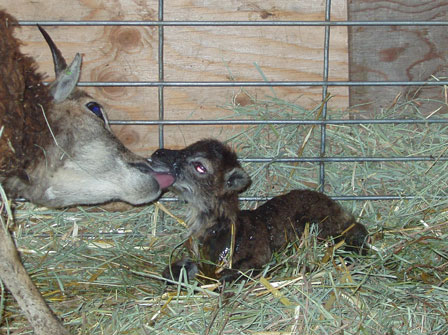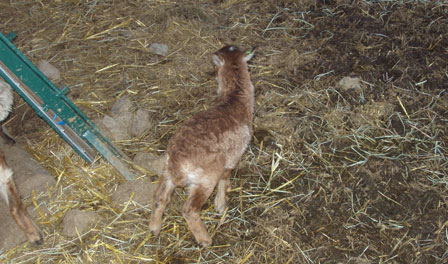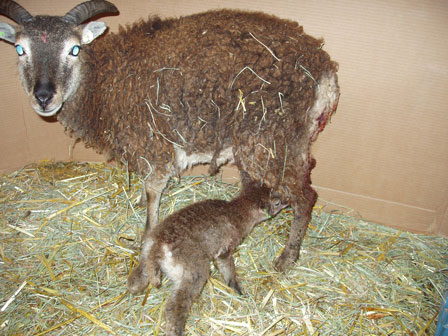First-time Soay Mothers
Some of the indications that a Soay ewe is about to lamb are seen only in an experienced ewe. If she is going to twin, she usually looks like a propane tank. Even if carrying only a single lamb, an older ewe will develop saddlebags and a waddle. The yearling ewes (“gimmers”) who are lambing for the first time exhibit more subtle signs of approaching labor, oftentimes surprising us when a lamb appears. They never have a big soft bag for several days or even several weeks before the lamb arrives, as do their matronly colleagues. In our experience, gimmers do not bag up until a few hours (at most) before they drop their lambs, and even then, their bags are hard to spot.
Leave it to Tolcarne (who happens to be the first British ewe born here) to lead by personal example and remind us shepherds of our limitations in the lamb forecasting department. It was not a dark and stormy night, quite the opposite. Friday afternoon was a peaceful time in the Maternity Ward, with nothing but the sound of 50 ewes eating for two and the muted thunder of 120 little hooves doing laps and wind sprints to break the silence.
Without warning, out of the corner of his eye Steve noticed The Kick, a tell-tale sign of a ewe in labor. We had not even been certain Tolcarne was pregnant. She had no poochy belly and no bag, but there she was, lying on her side, vigorously kicking straight out horizontally, not at all the langorous stretching they do all the time, pregnant or not. I have never been able to capture The Kick on camera, but I promise you, when first you see a ewe executing The Kick, you will recognize it as something new, something different. It is unlike any of the other gestures in the Soay repertoire.
Most ewes proceeding through labor get up and down a number of times in a restless Birth Dance. But not so Tolcarne. In obvious discomfort, she just lay there grunting and whimpering, frightened and in pain. Steve managed to nudge her into a jug, concerned about her immaturity and inexperience and wanting her in a relatively clean, dry place with no distractions. And in fact, she did have an uncommonly hard time getting her lamb out, to the point that Steve took the nearly unprecedented step of intervening, gently rolling back enough skin to ease it over the top of the lamb’s skull. Unlike the body of the lamb, which can be squeezed out and is quite malleable, its skull and front feet, which come out together, do not give at all. Anyway, once Steve helped get the lamb’s head moving, the rest of the package plopped right out in a few seconds.
We were startled. Given how much exertion it took Tolcarne to give birth, we could not believe how small her lamb actually was. And Tolcarne had so exhausted herself that she lay immobile for a long 5 minutes. This is most unusual for our ewes, who either birth standing up or immediately get up, licking and gurgling, and get right to work on the lamb.
Fortunately for the lamb, Steve had rubbed her nose just enough while she was coming out to break the membranes, allowing our miniature Soay creature to start bellowing like a miniature Soay bull or, more accurately, a miniature mezzo soprano. Gilbert and Sullivan, here we come! At first we worried that we had a preemie on our hands, with the attendant lung problems, in particular the possibility that her lungs, which are collapsed in utero, would not convert to “balloon mode,” as must all babies right at birth. To our relief, we concluded a preemie with lung problems could not possibly make this much racket. It was a very encouraging sign and just plain funny in an otherwise somewhat tense situation.
Tolcarne, on the other hand, was not as impressed as we were with her squalling, slimy bundle of joy. Her life had just taken a dramatic, irreversible, and from the look on her face, not entirely welcome turn: “This is not the career path I had in mind.”

Other than dipping the cord in iodine, we elected to leave Tolcarne alone for the post-birth cleaning and first meal. Steve does not like to “work” lambs with gloves on and it seemed too soon to handle the tiny lamb with bare hands. By this time Tolcarne had roused herself and was starting to get down to business, so we decided it was safe to leave the two of them alone for their ancient, instinctive rituals.

Back to the house we went for our own dinner (Note to self: do a blog posting on the realities of human meal planning during lambing). Turns out we need not have worried about this little lamb’s resourcefulness. When we returned to the Maternity Ward to work her it was dark. All forty-plus lambs, having found their mothers, had with one exception turned in for the night. You can guess who the holdout was. Once again she was bellowing, but this time from amidst the general population of bedded-down ewe-lamb pairs. Somehow she had managed to crawl out of the jug through the bars of a Shaul panel and had marched right out into the fray, where I found her surrounded by – in relative terms – elephants and dinosaurs. No baby Mozart this lamb; she was in full Wagnerian coloratura, waking everyone up with her high notes.

Back to the jug she went. Up went cardboard, plywood, anything we could find to secure the four sides of the jug. We were not about to lose a precious little British ewe lamb to sleep-walking.
Working her started uneventfully enough — Good temperature (102.4), easy tagging, injections without undue wiggling. Then came the weigh-in. Even carrying her back to the jug could not have prepared me for seeing a mere 2 pounds 6 ounces register on the scale, almost a full pound less than the smallest lamb we have ever had, and at least two pounds smaller than average. Where did all that lung power come from? How could she possibly have had the strength to start a cross-country trek at the age of two hours?
Now it is three days later and little Otley (named for a small town in Yorkshire) is to all appearances doing just fine. She has not managed to get out of her cardboard-lined nursery again and she gets up and feeds regularly. Little mama’s brand new bag also is functioning just fine, thank you.

We remain concerned that Otley’s small size may present problems over the next few weeks, but at this point, she is every bit as robust as her larger cousins.
Meanwhile Tolcarne has, to our great relief, concluded that motherhood may compare favorably with a career outside the home after all. And besides, with Otley’s musical talents, she may yet support her mother in Tolcarne’s dotage.
For now …